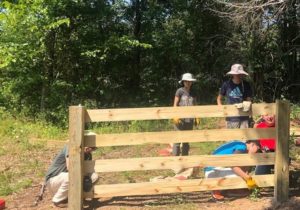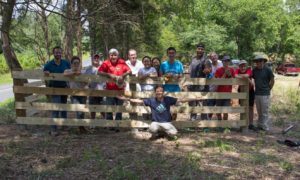 The task seemed daunting at first. Breaking the earth for my Eagle Scout project was no easy feat. I wanted to construct the front fence of the start of a new equestrian park for a local non-profit horse equine-assisted therapy organization. Driving out to the property, parking on the side of the road, I tried to peer in to see what I was working with. I shook my head in disbelief; from the road, I could not walk even ten feet into the property. It was overgrown, trees lining the front of the property, and bugs swarming my every step. How was I supposed to build a fence where I couldn’t even see the ground? However, I chose to help the organization; helping the therapy center made me feel meaning in my work, and the knowledge that less fortunate children could benefit from it only convinced me more to take this project on.
The task seemed daunting at first. Breaking the earth for my Eagle Scout project was no easy feat. I wanted to construct the front fence of the start of a new equestrian park for a local non-profit horse equine-assisted therapy organization. Driving out to the property, parking on the side of the road, I tried to peer in to see what I was working with. I shook my head in disbelief; from the road, I could not walk even ten feet into the property. It was overgrown, trees lining the front of the property, and bugs swarming my every step. How was I supposed to build a fence where I couldn’t even see the ground? However, I chose to help the organization; helping the therapy center made me feel meaning in my work, and the knowledge that less fortunate children could benefit from it only convinced me more to take this project on.
There were many, many preconditions that I had to deal with before even beginning my fence. The grasses loomed over my knees. The thickened brush scratched at my feet. I started planning the phases like it was the procedure for a chemistry experiment. After countless hours of research and writing it to paper, I created a specific project plan that ranged from the purchase of lumber to the cleanup of the property after completion. There were times when I wanted to scrap it all up, try something else, but I pushed through and I finally set the plan in action.
 On the day of the project, after all the preparation, laying out the construction flags, measuring the fence distance, and renting equipment, I thought a fence cannot be that difficult to construct right? I was wrong. Off the bat, I faced even more obstacles. Drilling holes in the ground proved to be a pain in the ass, brittle, rocky earth testing my paper plan. After all the work I put in, I was not going to be stopped by a faulty power auger. My perfect plan was put to a halt in its tracks. As I pondered the possibility of working well into the night, it dawned on me that I should implement Plan B, one that just sprung into my mind. Keeping the workers focused and not idle became a new priority as the other parts of my old plan finished. I diverted my resources to help drill holes. Through the beating sun, we finally managed to finish the project after seven hours of hard labor, in front of me was a completed 300-foot fence. I would have never thought I would transform the wilderness into an orderly, pretty fence, a trailblazer for the equestrian park.
On the day of the project, after all the preparation, laying out the construction flags, measuring the fence distance, and renting equipment, I thought a fence cannot be that difficult to construct right? I was wrong. Off the bat, I faced even more obstacles. Drilling holes in the ground proved to be a pain in the ass, brittle, rocky earth testing my paper plan. After all the work I put in, I was not going to be stopped by a faulty power auger. My perfect plan was put to a halt in its tracks. As I pondered the possibility of working well into the night, it dawned on me that I should implement Plan B, one that just sprung into my mind. Keeping the workers focused and not idle became a new priority as the other parts of my old plan finished. I diverted my resources to help drill holes. Through the beating sun, we finally managed to finish the project after seven hours of hard labor, in front of me was a completed 300-foot fence. I would have never thought I would transform the wilderness into an orderly, pretty fence, a trailblazer for the equestrian park.
I learned many things from my Eagle Scout project. It gave me the confidence to tackle large, complex projects and taught me perseverance. By splitting up the project into stages and planning it all out, it started to look more straightforward. It really showed how hard work pays off and that planning is a necessity with projects of this scale. But I also learned that even the most-detailed, seemingly perfect plans have plenty of opportunities to face flaws.

